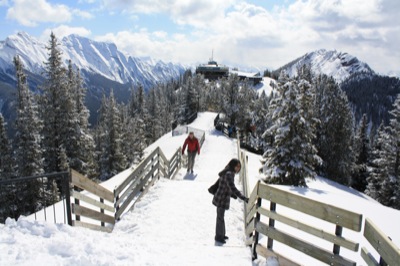
I looked out at the sideways landscape in wonder. From all I had learned about gravity, the bus should be skidding straight down the almost perpendicular icy slope. Yet Brewster Ice Explorers’ massive tires allow the 42-foot-long tour bus enough traction to leisurely roll down the Columbia Icefield’s scarily steep hill.
“Want to see how fast this thing can go?” asked Bob, my Ice Explorers driver as the bus continued to crawl along the ice. “That’s it: 12 miles per hour. It doesn’t go any faster than this, and you wouldn’t really want it to because there is 1,000 feet of ice under the road, and when the ice shifts, so does the road.”
The Canadian Rockies’ Columbia Icefield Glacier Adventure allows visitors to experience the indescribably gigantic ice field by driving guests on the surface of the Athabasca Glacier. This bizarre white landscape is one of the largest accumulations of ice and snow south of the Arctic Circle, with an area of nearly 202 square miles.
Stepping out of the bus onto the glacier, I could scarcely believe the view. Massive white mountains encircled me, with the unearthly blue glacier ice visible between several of the mountains. I finally understood the scale of my surroundings when I spotted a cross-country skier at the base of Mount Athabasca who looked no bigger than a dot.
“Good climbers take about six to eight hours to climb Mount Athabasca,” said Bob, pointing to the mountain. “They start climbing at 4 a.m. But bad climbers, they’ve been known to come down in eight seconds.”
I discovered the ancient beauty of the Columbia Icefield on a tour through the heart of the Canadian Rockies with Collette Vacations during a very snowy April. On the tour, I learned the joys of traveling through an area still in the throes of winter.
Tree walking
My tour started in Vancouver, where Canada’s white-capped mountains meet the ocean. It is one of the few places in the world where visitors can ski down a mountain, relax at a beach and walk through a rain forest in the same day.
I stepped into one of Vancouver’s rain forests at the Capilano Suspension Bridge. To enter the forest, visitors must first cross the 450-foot-long suspension bridge that swings 230 feet above the valley below. Although the swaying movements of the bridge took some getting used to, I enjoyed the bridge’s views of distant mountains and a waterfall.
Inside the rain forest, towering Douglas firs and western hemlocks blocked out the sunlight by creating a green canopy above.
“George Grant Mackay came here from Scotland in 1888 and decided that these 27 acres were the most beautiful in the area,” said Hanna Holbrook, guide at the Capilano Suspension Bridge. “So George built the first suspension bridge in 1889. There are now seven suspension bridges in the park. You can start to feel like a squirrel running through the treetops.”
I walked across the other six suspension bridges that connect various trees to see the forest from a higher vantage point. Many of the Douglas firs had been growing for hundreds of years, developing barks so thick that they could survive a forest fire.
I continued my tour of Vancouver’s natural beauty by taking a stroll through the 1,000-acre Stanley Park. City council officials created Stanley Park as their first resolution after Vancouver became an incorporated city in 1886.
“Where we stand today is really a rare forest and something to guard for the future,” said Patricia Thomson, executive director of the Stanley Park Ecological Society. “Not only are we an iconic ecological park, but it is also an important city park. It’s probably the most well-known park in Canada.”
Continuing on, I saw the urban side of Vancouver at historic Gastown, Vancouver’s Chinatown and Granville Island, and viewed the Olympic torch in front of the Vancouver Convention Centre.
All aboard!
I awoke the next morning to a Narnia-like dreamland inside a private train cabin with Via Rail Canada. By morning, the overnight train from Vancouver to Jasper had already entered the Canadian Rockies.
Outside my window, falling snowflakes filled the vast expanses of streams, fields and mountains covered with dark evergreens. The remote surroundings had few signs of human activity, but wildlife seemed to be plentiful as evidenced by animal tracks in the snow and moose sightings.
Reveling in the vistas from my room, I realized the benefits of taking this journey by train rather than air or motorcoach, as the ride offered plenty of leg room, public cabins in which to socialize and private bathrooms. To my delight, the trains even had showers.
Not long after eating lunch aboard the train, I arrived at the Fairmont Jasper Park Lodge for the night. The next day, I saw two things I had never seen before: a dog with a lifejacket and a raft on a river with floating pieces of ice. Although the weather was expected to melt the ice in a couple of weeks, the staff at Jasper Raft Tours wanted to give my group a demonstration of the raft experience despite the ice and snow.
“Don’t worry, we have a policy of not letting you into the water,” said Scott Eady, general manager of Jasper Raft Tours. “These trips are very calm. The rafts can float two suburban trucks.”
A shaggy dog named Molly with her own custom-made lifejacket joined the short raft ride past icicles and snowy banks. The raft guide kept everyone aboard entertained with jokes and interesting facts about the area.










